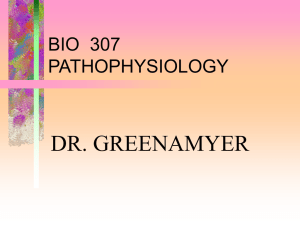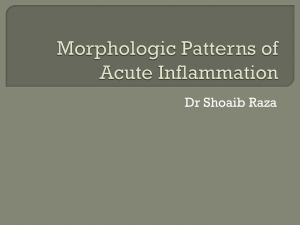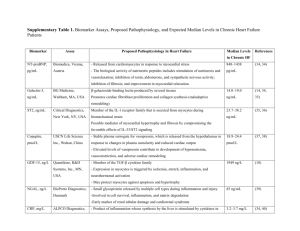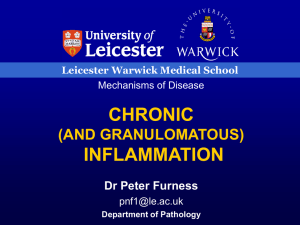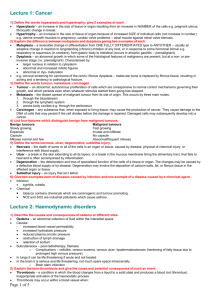TIME_MAG_INFLAMMATION_5_1 Click to
advertisement
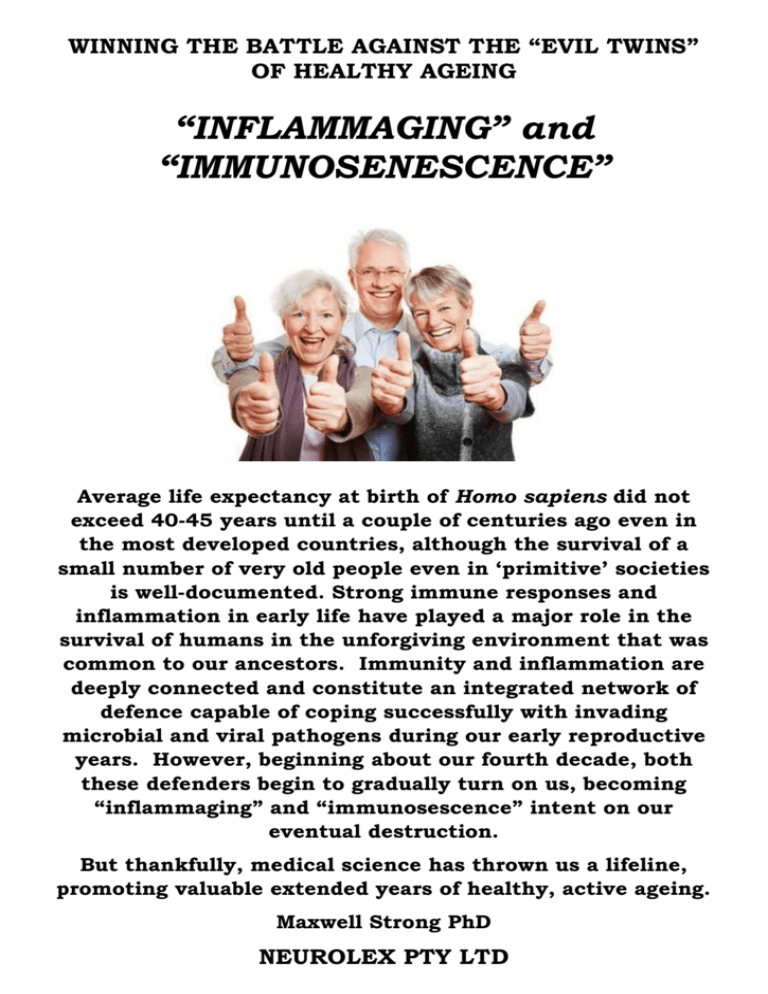
WINNING THE BATTLE AGAINST THE “EVIL TWINS” OF HEALTHY AGEING “INFLAMMAGING” and “IMMUNOSENESCENCE” Average life expectancy at birth of Homo sapiens did not exceed 40-45 years until a couple of centuries ago even in the most developed countries, although the survival of a small number of very old people even in ‘primitive’ societies is well-documented. Strong immune responses and inflammation in early life have played a major role in the survival of humans in the unforgiving environment that was common to our ancestors. Immunity and inflammation are deeply connected and constitute an integrated network of defence capable of coping successfully with invading microbial and viral pathogens during our early reproductive years. However, beginning about our fourth decade, both these defenders begin to gradually turn on us, becoming “inflammaging” and “immunosescence” intent on our eventual destruction. But thankfully, medical science has thrown us a lifeline, promoting valuable extended years of healthy, active ageing. Maxwell Strong PhD NEUROLEX PTY LTD 2 CHRONIC SYSTEMIC INFLAMMATION (AND OXIDATIVE STRESS) IF UNCHECKED, BEGIN THEIR PATHWAY TO CHRONIC DISEASE MORBIDITY AND MORTALITY Following is a copy of the first several paragraphs of the excellent cover article THE SECRET KILLER by authors Christine Gorman, Alice Park and Kristina Dell and which featured in the TIME magazine of February 23, 2014. We have reproduced this extract because of its even greater importance now, over a decade later, as we face a “Tidal Wave” of age-related chronic disease, dubbed, the Silver Tsunami. Although often not manifesting clinically for some years, chronic systemic inflammation actually develops progressively from our fourth decade, becoming known later as “inflammaging”. “What does a stubbed toe or a splinter in a finger have to do with your risk of developing Alzheimer’s disease, suffering a heart attack or succumbing to colon cancer? More than you might think. As scientists delve deeper into the fundamental causes of those and other illnesses, they are starting to see links to an age-old immunological defense mechanism called inflammation – the same biological process that turns the tissue around a splinter red and causes swelling in an injured toe. If they are right – and the evidence is starting to look pretty good – it could radically change doctors’ concept of what makes us sick. It could also prove a bonanza to pharmaceutical companies looking for new ways to keep us well. Most of the time, inflammation is a lifesaver that enables our bodies to fend off various diseasecausing bacteria, viruses and parasites. (Yes even in the industrialized world, we are constantly bombarded by pathogens.) The instant any of these potentially deadly microbes slips into the body, inflammation marshalls a defensive attack that lays waste to both invader and any tissue it may have infected. Then just as quickly, the process subsides and healing begins. Every once in a while, however, the whole feverish production doesn’t shut down on cue. Sometimes the problem is a genetic predisposition; other times something like smoking or high blood pressure keeps the process going. In any event, inflammation becomes chronic rather than transitory. When that occurs, the body turns on itself – like an ornery child who can’t resist picking a scab – with aftereffects that seem to underlie a wide variety of diseases. Suddenly, inflammation has become one of the hottest areas of medical research. Hardly a week goes by without the publication of yet another study uncovering a new way that chronic inflammation does harm to the body.. It destabilizes cholesterol deposits in the coronary arteries, leading to heart attacks and potentially even strokes. It chews up nerve cells in the brains of Alzheimer’s victims. It may even foster the proliferationn of abnormal cells and facilitate their transformation into cancer. In other words, chronic inflammation may be the engine that drives many of the most feared illnesses of middle and old age. This concept is so intriguing because it suggests a new and possibly much simpler way of warding off disease. Instead of different treatments for, say, heart disease, Alzheimer’s and colon cancer, there might be a single, inflammation-reducing remedy that would prevent all three. A decade ago, researchers were blaming oxidative damage (‘free radicals’) for everything from cancer to heart disease. Now chronic (innate) low-grade inflammation is seizing the spotlight. “Inflammation is the evil twin of oxidation”, says neuroscientist James Joseph of Tufts University. “Where you find one, you find the other”. 3 OUR PROBLEM DEVELOPS DRAMATICALLY AND PROGRESSIVELY FROM MID-LIFE The proportions of Australians with one or more chronic conditions increases with age as shown in the following data published by The Australian Institute of Health and Welfare. Age increases 0-14 years 15-24 years 25-44 years 45-64 years 65+ years % WITH CHRONIC DISEASE None 86.9 80.8 74.0 47.0 18.4 One 12.3 17.0 21.0 32.0 32.0 Two 0.8 1.9 3.8 14.1 26.7 Three - 0.3 1.1 5.1 15.3 Four - - 0.2 1.4 5.0 Five or more - - - 0.5 2.6 % more than one 13.1 26.0 53.0 81.6 3.62 4.64 5.34 C-Reactive Protein (CRP) mg/L 19.2 2.99 You may have noticed that from about our 45th year, our chronic disease conditions more than double. And you will notice too, our level of chronic systemic inflammation (CRP), gradually increases with age, a condition known as “inflammaging”. But why? Fortunately for the answer, we simply have to turn to the study by researchers from Emory University, USA who discovered that from about age 45 years, the level of our body’s chief natural antioxidant, glutathione, drops dramatically, resulting in a progressive increase in oxidative stress, or ‘redox imbalance’. And you guessed it, this increasing oxidative stress of course triggers activation of our natural ‘master regulator’ of inflammation, the protein Nuclear Factor-kappa B (NF-kB), and with it progressively begins a cascade of pro-inflammatory cytokines. This is clearly shown in the gradual increase in our levels of C-Reactive Protein, the serum biomarker of chronic systemic inflammation, in a study of US adults. Suddenly medical puzzles seem to be fitting together, such as why rheumatoid-arthritis sufferers have higher rates of sudden cardiac death. They’re all connected on some fundamental level – which raises a tantalising question. If there are these common threads, which we call the “fertile ground”, in the development of all these diseases, are there common treatments? Medical researchers are eager to find out. But it’s not as simple as it seems. If you can’t live with inflammation, you can’t live without it, either. Inflammation is a component of the immune system’s defences. The problem is that, as you will see from the chart, it gradually increases with age (“inflammaging”) and unless contained at safe levels, continues its damage to tissues, cells and organs throughout our body, resulting finally in chronic disease. This knowledge is beginning to change clinical approaches to treatment. But taming the immune system isn’t as simple as it sounds. Here’s the catch. With ageing, there is already a gradual decline in our immunity (immunosenescence), and If you turn down the central switches controlling inflammation too much, you run the untoward risk of secondary bacterial and viral infections. Inflammation is an important part player in our immune defence against invading pathogens. Reduced too far, we are like sitting ducks, helpless against any pathogen coming our way. 4 Inflammation increasing with age (“inflammaging”), and immunity decreasing with age (“immunosenescence’), - the double whammy we don’t need for healthy ageing; and this combination resulting in increased age-related morbidity and morbidity. Eventually, it became clear with intense examination of several thousands of published university studies that protection lies in a group of phytochemicals found in certain fruits, eventually narrowing this to a subclass of polyphenols known as flavonoids, epicatechins and flavanols. These demonstrate very potent inhibitory action against our evil twins, oxidative stress and chronic inflammation. They also demonstrate selective toxicity to transformed or cancer cells, whilst at the same time, providing protecting for normal healthy cells. However, still confronting us was the problem of epigenetic changes to our chromatin which had to be overcome. And it was here that we eventually discovered the solution in a particular type of soluble fibre found in some vegetables. But in successfully lowering systemic chronic inflammation, which is readily demonstrated with the exquisite blood biomarker, serum C-reactive protein (CRP), we would also diminish an important component in our natural defence against the ever-present possibility of attack by invading pathogens such as bacteria or viruses. We finally discovered that this dietary fibre comes to our rescue. Metabolites, particularly butyrate, produced by friendly health-promoting bacteria present in our gut, when fed this fibre, not only have both antiinflammatory and antioxidant functions, but also actually augment our body’s production of antimicrobial peptides, resulting in a vital boost in our natural immunity against invading pathogens, whilst at the same time protecting against chromatin dysregulation. Importantly too, we found that MIT neurologists also had discovered that these same gut bacterial metabolites were able to augment brain plasticity, cognitive function, and restore memory and learning function in mice bred to develop the human form of Alzheimer’s disease, even restoring memory long since gone. These antimicrobial peptides are known as important effectors of our innate defence that demonstrate broad-spectrum activity against a wide range of invading microorganisms including both Gram-positive and Gram-negative bacteria, protozoa, yeast, fungi and viruses. This is particularly important at present with the emergence of multidrug resistance in a number of medically important bacterial species. All this science is now incorporated in a 100% natural, drug-free, safe and effective fruit and vegetable concentrate, extracted and standardised in the proprietary soluble food powder ingredient known as NEUROLEX*. And the results are evident in the ever-widening group of people now regular users of this product, ranging from enhanced feelings of wellness and health, to medically-documented cancer elimination even in advanced cancers, complete stroke recovery, enhanced heart function, and the list continues to increase. A truly ‘breakthrough’ development in healthy wellbeing ,NEUROLEX* is the first and only, evidence-based, completely-natural, safe, totally fruit and vegetable-derived, food concentrate to simultaneously reduce the damaging effects of oxidative stress, chronic systemic inflammation, and chromatin dysfunction, whilst actually boosting the body’s immune function with augmented antimicrobial peptide levels. A truly unique, evidencebased key to healthy ageing. Dr. Strong enthusiastically welcomes enquiries from medical researchers, medical specialists, medical practitioners as well as interested members of the public, and can be contacted on (02) 9531 8585, Mob: 0418 413657. Email: mendel_inst@prontomail.com NEUROLEX PTY.LTD. Note; *This product is protected by current Patent Pending 2015900919. As always we encourage you to discuss all health concerns with your doctor.



